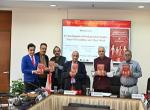On 5th August 2024, Vivekananda International Foundation (VIF) organised a Vimarsh on ‘The Indic Religious Tradition: An Outline’ by Prof. Arvind Sharma, Birks Professor of Comparative Religion in the School of Religious Studies at McGill University in Montreal, Canada, and formerly part of the Indian Administrative Service (IAS). Prof. Sharma has also taught at various universities in the United States (Northeastern, Boston, Temple, Harvard), Australia (Queensland, Sydney), and India (Nalanda). He has published extensively in the field of Indian religions and comparative religion. He was the General Editor of the Encyclopaedia of Indian Religions (2017). Prof. Sharma was also instrumental in adopting the Universal Declaration of Human Rights by the World’s Religions at a global conference held in Montreal in 2016.This was the fifth talk in the series of lectures and discussions at VIF on Indic religious traditions.
Dr. Arvind Gupta, Director, VIF, in his opening remarks of the session thanked Shri S. Gurumurthy, Chairman, VIF, for his participation in the talk and also congratulated Prof. Sharma for completing the lecture series on the Indic religious traditions. Dr. Gupta briefly talked about the philosophical traditions of India, Varna, and Asrama and the relationship between Hinduism and Buddhism.
In the keynote address, Prof. Arvind Sharma talked about the various names by which the Indic religious traditions can be referred, like Bharat-Mulaka Dharma Parampara (a translation of Indic religious tradition) and Sanatana. One possible disadvantage of the word Sanatana is that it is associated with the Hindu religious traditions as a whole. One could also use the word Dharma for all the religious traditions. The difficulty, however, which this presents is that the word dharma has come to be used now in Indian languages as a synonym for the English word religion. Another suggestion was Om Dharma, as the symbol of Om is closely associated with Hinduism. Om is also associated with Buddhism and Jainism. The role of Om in Sikhism hardly calls for any elaboration: ek omkar is there in Sikhism. Another term that is used in all Indic religious traditions is the word, Moksha. Attaining Moksha is the common goal of all the Indic religious traditions; hence, these religions can be termed Moksha Dharma.
Prof. Sharma talked about the scriptures in the Indic religious tradition. These scriptures would naturally include: the scriptures of the Hindu tradition known as sruti and smrti; the scriptures of Buddhism as found in the Theravada and Mahayana; the scriptures of Jainism, of its Digambara and Svetambara traditions; and the Guru Granth Sahib of the Sikhs. It would not be out of place to suggest that the word Veda could be used to cover all these texts. This might sound a bit arbitrary, but the fact remains that the Hindu texts have been called the Vedas of the Brahmana and the Buddhist texts have been called the Vedas of the Sramanas. Similarly, the Guru Granth Sahib has been called the Sikh Veda; according to some scholars, the Rig Veda may even have served as a template for the Guru Granth Sahib. There is evidence, from medieval India, that the word Veda was sometimes used by Indic scholars to refer to the revealed texts of even religions that did not originate in India, such as Islam.
Prof. Sharma described the deities of the Indic religious tradition. The Hindu trinity of Brahma, Vishnu and Shiva appears in all the four religions of Indian origin. In fact, in Buddhism, it is Lord Brahma who invites the Buddha, after his Realisation, to go forth and share his wisdom with the people. The gods of the Hindu Trinity, however, are also subjected to criticism within Buddhism and Jainism, wherein they are accorded a status somewhat beneath the holy figures of their own religion. This, however, also happens within the Hindu tradition.
Rama and Krishna, who are very prominent figures within Hinduism, are also mentioned in the Jataka stories. There is a Jataka story according to which the Buddha was born as Ram in his previous incarnation. Jainism alters the Ramayana story to suit its doctrines. In the Jain version of the Ramayana, Rama does not kill Ravana, as that would not befit a Jain hero, a tradition committed to ahimsa. The killing of Ravana is done by Lakshmana. The words Ram and Krishna also appear numerous times in the Guru Granth Sahib. The word ‘Ram’ appears more than 2500 times in Guru Granth Sahib. The word ‘Hari’ appears 8344 times and ‘Govind’ 475 times in the same text. According to the Jain tradition, the Jain Tirthankara Aristanemi was a cousin of Krishna, highlighting the family relations between gods of the two Indic religions.
The next important aspect of the Indic religious traditions is their ethics. Each of the four Indic religious traditions has its own specific rites and rituals, which vary among themselves. However, this must not obscure the fact that all of them subscribe to certain basic ethical propositions. Perhaps the best way to develop this point is to recognise the distinction between what are called visesha or prithak dharma, or duties, and what are called sadharana or samanya dharma, or duties. The first category of dharma refers to the specific duty of a class, tradition or sect that is incumbent upon those who belong to it, while the second set of duties applies to all human beings irrespective of their class, caste, or faith. The sadharana dharmas find a place in all the four religions of Indian origin: to abstain from taking life; to abstain from telling lies; to abstain from stealing; to abstain from improper sexual conduct; and to abstain from intoxicants.
The values of the Indic religious tradition can be presented in terms of Dharma, Artha, Karma and Moksha. These values aim to secure the best for a human being both in this world and the next. This general aspiration is shared by all the four religions of Indian origin. Hinduism openly advocates the cultivation of the good life both in this world and the next. Buddhism and Jainism, despite their more pronounced monastic orientation, seek the best for their followers. Sikhism, despite its pronounced commitment to life in the world, does not ignore the spiritual dimension of life.
One could next turn to the sociology of the Indic religious tradition, especially the position of women within the Indic religious tradition. The monastic elements in these religions tend to view women in general with disfavour. Sikhism provides an interesting perspective here by giving women a role in its martial tradition. Nevertheless, all four religions have been criticised on the basis of the actual position of women in these traditions, which often contrasts with the more idealistic formulation of their position within the traditions themselves. Prof. Sharma attempted to present an outline of the Indic religious traditions, if it were to be presented in terms of its name, its history, its scriptures, sociology, and so on.
Ramchandra Gandhi, a well-known Indian philosopher, once declared that a metaphysical reconciliation of Hinduism and Buddhism is the great unfinished task of Indian philosophy. A similar question was raised by Professor Fritz Staal, a well-known figure in Indology. Prof. Staal recounted that while teaching Indian philosophy, he described the concept of Brahman to the class as something that was without differentiation, internal or external. Then, when he came to Buddhism, he described the concept of sunyata, or emptiness, which again was empty of all distinction and differentiations. Thereupon a Chinese student asked him the following question: If Brahman could not be differentiated from anything and neither could Sunyata, then how could the two be differentiated from each other? Therefore, they must be the same. Prof. Staal complimented the student and concurred with the student. If Prof. Staal's position was correct, then we obviously had in it the possibility of metaphysical reconciliation between Hinduism and Buddhism. Prof. Sharma felt that it was too good to be true, despite the fact that the Maitri Upanishad refers to the ultimate reality as both Brahman and Sunya.
Prof. Sharma proposed a slightly different model for the metaphysical reconciliation of Hindu and Buddhist thought with the example of the nature of light in modern physics, namely whether it is a wave or a particle. One way of reconciling these two aspects would be to recognise that some aspects of the behaviour of light are best explained on the assumption that it is a particle, and other aspects of the behaviour of light are best explained on the assumption that it is a wave. Similarly, the concept of Brahman assumes that it is a permanent entity. The concept of Sunya argues that there is no such permanence. Both these positions are conceptual formulations, and therefore it could well be that some aspects of the ultimate reality are best understood when it is treated as permanent. The other aspects of the same ultimate reality are best understood by treating it as not permanent. In his concluding remark. Prof. Sharma said that all of us are born Hindus, and we should be compassionate like Buddhists, fight like Sikhs, and die like Jains.
Shri. S. Gurumurthy talked about the emergence of rigid ideologies based on religion, which tend to suppress dissenting opinions, fostering a sense of exclusivity. Each ideology asserts its own correctness while denouncing others, thereby widening the divides between them. In contrast, the Indic traditions stand apart by eschewing rigid ideologies. India is renowned for its philosophical traditions, known as Darshanas, which encourage dialogue and discourse among diverse viewpoints. This emphasis on dialogue, embodied in the concept of Tarkashashtra, has enabled the Indic traditions to persist peacefully for millennia, fostering an environment where ideas can flourish without resorting to violence. The result of such practices was that anger was seen as a sign of defeat. The session was then open for discussion, followed by closing remarks by Dr. Arvind Gupta.







Post new comment